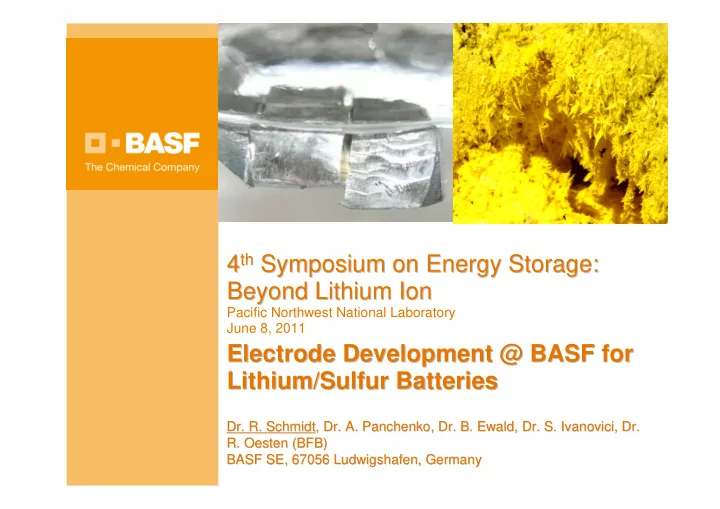

th Symposium on Energy Storage: 4 th Symposium on Energy Storage: 4 Beyond Lithium Ion Beyond Lithium Ion Pacific Northwest National Laboratory June 8, 2011 Electrode Development @ BASF for Electrode Development @ BASF for Lithium/Sulfur Batteries Lithium/Sulfur Batteries Dr. R. Schmidt, Dr. A. Panchenko, Dr. B. Ewald, Dr. S. Dr. R. Schmidt , Dr. A. Panchenko, Dr. B. Ewald, Dr. S. Ivanovici Ivanovici, Dr. , Dr. R. Oesten (BFB) R. Oesten (BFB) BASF SE, 67056 Ludwigshafen, Germany BASF SE, 67056 Ludwigshafen, Germany
BASF Lithium/Sulfur Research Partner � Since 2009 joint development agreement with world-leading lithium/sulfur company Sion Power � Sion Power major developer of Li/S battery systems and protected lithium anode technology � Acceleration of Li/S research and development with BASF expertise as chemical solution provider 2
Li/S – The Battery System Beyond Li-ion Advantages: Today Future Theory � High gravimetric energy 3000 density � Low cost and abundant 2000 raw materials � Ideal battery system for full 1000 electric vehicle application � Operability at very low 0 temperatures Li-Ion Li/S Li-Ion Li/S Gravimetric Energy Volumetric Energy � High potential of improvement [Wh/kg] [Wh/l] Comparison Li-Ion vs. Li/S batteries Outstanding superiority of Li/S in respect of gravimetric energy density 3
Potential and Challenges Capacity (mAh/g) � “Life” of Li/S 1.200 batteries ends 1.000 currently too early after 50-100 cycles 800 (< 800 mAh) Li/S 600 � Goal: > 500 cycles 400 � Observed capacity LIB five times higher 200 than lithium-ion batteries 0 0 10 20 30 40 50 Cycle no. Comparison of cycle data of Li/S cell (red = discharging, blue = charging) and lithium-ion battery (LIB). Five times higher capacity than Li-ion technology 4
Working Principle of Li/S System Discharging: Polysulfide Shuttle � Li is stripped from �� � �� � Li 2 S 8 S S S S Li anode and lithium S S Li S S S S Li �� � �� � Li S S �� � sulfides are formed in �� � Separator S Li Li 2 S 6 ������ Li S S S S S Li the cathode Li S S S S ������ S S Li 0 �� � �� � ������ Li S Li Li 2 S 3 S S Li �� � Li S S �� � S S Li Charging: �� � Li S S S S S Li S Li S S Li 2 S �� � � Re-plating of Li and re- Anode Cathode Charge (Li plating) ( – ) ( + ) formation of elemental Discharge (Li stripping) sulfur Model of Lithium/Sulfur battery Speciality of Li/S: (Partly) dissolving electrodes during cycling 5
Discharge Curve Potential (V) vs Li/Li + First Stage First stage 2.4 � Elemental sulfur is reduced 2.3 � Polysulfide up to Second stage 2.2 Li 2 S 4 are formed 2.1 Second Stage � Precipitation of Li 2 S 2.0 Theoretical � Formation of smaller capacity 1.9 polysulfides � 65-75 % of sulfur 1.8 0 400 800 1200 1600 usage Specific capacity (mAh/g Sulfur) Speciality of Li/S: (Partly) dissolving electrodes during cycling 6
Cathode Development Special requirements: 1.400 � Sulfur cathode sensitive to 1.200 Capacity [mAh/g] 1.000 drying under vacuum � Partly dissolving cathode 800 600 � Carbon particles responsible capacity drop ~ 50 % 400 for structural stability 200 Approach: 0 � Utilization of new carbon 0 10 20 30 40 50 Cycle no. materials State of the art Li/S battery with Teflon binder � Pretreatment of carbon and sulfur material Binder and carbon development is key factor for optimized cathode 7
Expanded Graphites � Intercalated graphites: Intercalation of Lewis acid guest molecules (e.g. SO 3 ) Intercalated Graphite: Graphite: intercalate Intercalation: e.g. Intercalation: e.g. + NO x / H 2 SO 4 + NO x / H 2 SO 4 Intercalation is key to expansion 8
Expanded Graphites Graphite Expanded Graphite “Pockets” for sulfur uptake � Expanded graphites can lead to better cell performance � Highly conductive and light material � Fixation of sulfur in pockets Micropockets 9
Expanded Graphites � Temperature / gradient controlled expansion: Temperature is key factor for optimized structure 10
Expanded Graphites 1.400 � Over 1100 mAh/g sulfur 1.200 over 50 cylces Capacity [mAh/g] 1.000 � Consumption of 800 electrolyte responsible 600 for cell failure after 60 cycles 400 200 � Testing in 110 mAh cells 0 � Up to 40% expanded 50 0 10 20 30 40 Cycle no. graphites in cathode Charge/discharge capacity of cell with improved cathode Highly stable performance for first 50 cycles 11
12
Recommend
More recommend